If your above-ground pool wall is broken, there are a few things you can do to fix it. Depending on the extent of the damage, you may be able to repair it yourself, or you may need to hire a professional. In either case, knowing what steps to take and what materials to use is essential. This blog post will provide a few methods for how to fix above ground pool wall.
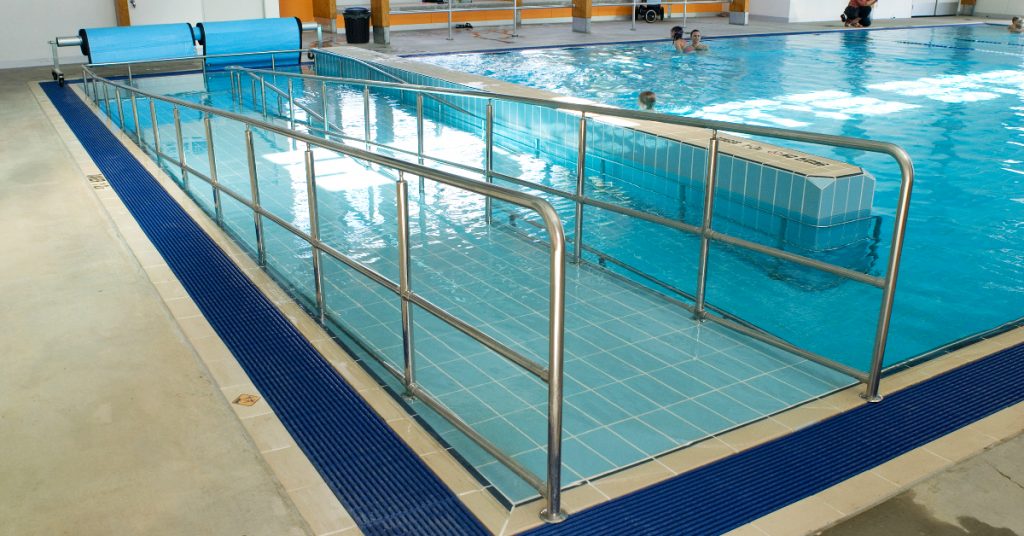
To maintain and keep an above-ground pool in good condition, it is important to fix any cracks or damages as soon as possible. If a crack in the wall of an above-ground pool goes untreated, it will only worsen over time and could potentially lead to leaks. Continue reading for more information on how to fix your swimming pool’s wall properly!
Summary: There are several options to fix this issue, including using Pool Putty or Epoxy, Fiberglass tape and resin, a pool patch kit, sandpaper to smooth out any rusted areas, and a pool wall repair kit. To find the leak, you can use a hose. Small leaks can be repaired with epoxy, while larger ones can be sealed with flexible caulking or an epoxy kit. If the problem is more serious, consider using Flex Seal or hiring a professional.
What Causes Damage Above Ground Pool Wall?
There are several reasons why an above-ground pool wall may become damaged. The most common reason is from weathering and wear and tear. Over time, the sun can cause the vinyl to become brittle and crack. The winter cold can also cause the metal to become brittle and break. Wind can also cause damage to an above-ground pool wall by blowing objects into it or causing the pool to collapse.
Another common reason for damage to an above-ground pool wall is improper installation. If the pool is not installed correctly, the weight of the water can cause the walls to buckle or collapse. The soil around the pool can also settle, causing the walls to lean inward. Improperly installed pools can also leak, which can cause the walls to rot or collapse.
How to Fix Above Ground Pool Wall: 12 Easy Solutions
1. Use Pool Putty or Epoxy:
If you have a small crack or hole in your above-ground pool wall, you can try to repair it with pool putty or epoxy. These are both specialized materials that can be found at most hardware stores. Apply the putty or epoxy to the crack or hole and smooth it over. Allow it to dry completely before using the pool again.
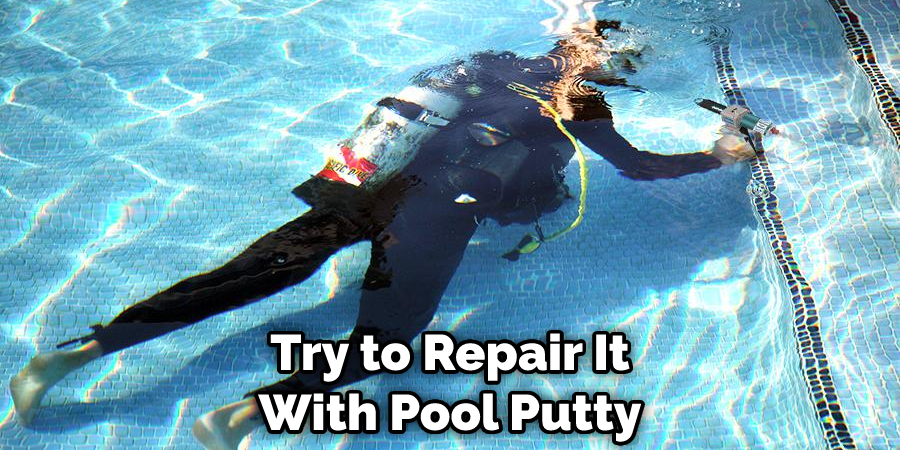
2. Use Fiberglass Tape and Resin:
You’ll need to use fiberglass tape and resin for larger cracks or holes in your above-ground pool wall. First, clean the area around the crack or hole with alcohol to remove any dirt or debris. Then, cut a piece of fiberglass tape to size and apply it over the crack or hole. Next, mix the resin according to the package instructions and apply it over the fiberglass tape. Allow everything to dry completely before using the pool again.
3. Use a Pool Patch Kit:
If you’re not comfortable working with pool putty, epoxy, or fiberglass tape and resin, you can also purchase a pool patch kit. These kits contain everything you need to repair small cracks and holes in your above-ground pool wall. Then, simply follow the instructions included with the kit to get the job done.
4. Use Sandpaper to Smooth Out the Rusted Areas:
If your above-ground pool wall is rusty, you can try to sand down the rust and then repaint the area. First, use a wire brush to remove as much rust as possible. Then, use fine-grit sandpaper to smooth out the remaining rust. Next, wipe down the area with a damp cloth and let it dry completely. Finally, apply a fresh coat of paint to the area.
5. Use a Pool Wall Repair Kit:
If you have significant damage to your above-ground pool wall, you may need to use a pool wall repair kit. These kits include everything you need to patch up large holes or tears in your pool wall. They are also relatively easy to use, so even if you’re not a pool repair expert, you should be able to patch up your pool wall with one of these kits.
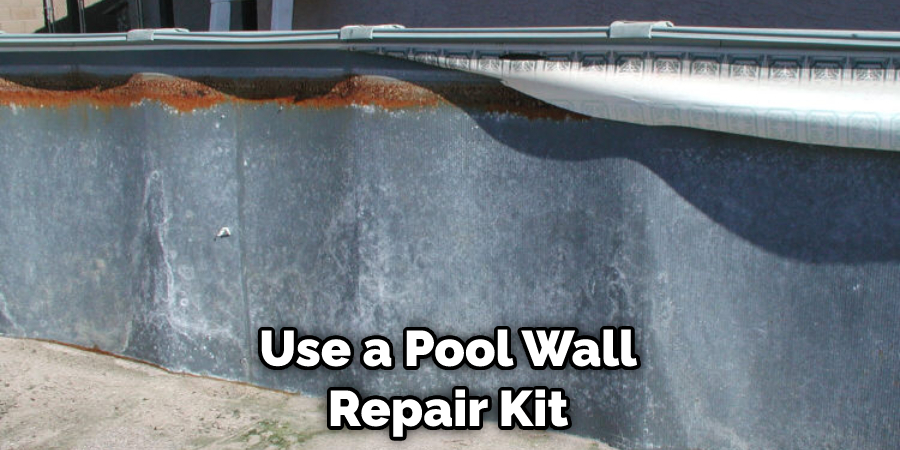
6. Replace Damaged Pool Wall Sections:
Sometimes, the damage to your above-ground pool wall may be too extensive to be repaired with a kit. If this is the case, you will need to replace the damaged sections of your pool wall. This is a more involved repair, but it can be done if you have some basic handyman skills.
You will need to purchase replacement panels for the damaged sections of your pool wall. These can be purchased from most pool supply stores or online retailers. Be sure to measure the damaged sections of your pool wall before ordering replacement panels so you get the correct size.
7. Use a Hose to Find the Leak:
If you suspect that your above-ground pool leaks, the first step is to locate the leak’s source. You can use a garden hose to fill up your pool. Once the pool is full, turn off the hose and check the water level in the pool the next day. If the water level has dropped, you leak. If your pool is losing water and you can’t identify the leak’s source, you may need to call a pool professional for help.
8. Repair Small Leaks with Epoxy:
If you’ve located a small leak in your above-ground pool, you can usually repair it with epoxy. First, clean the area around the leak with a brush and vinegar solution. Then, apply the epoxy to the leaky area and smooth it out with a putty knife. Allow the epoxy to dry for 24 hours before adding water to your pool. When you’re finished, your pool should be good as new!
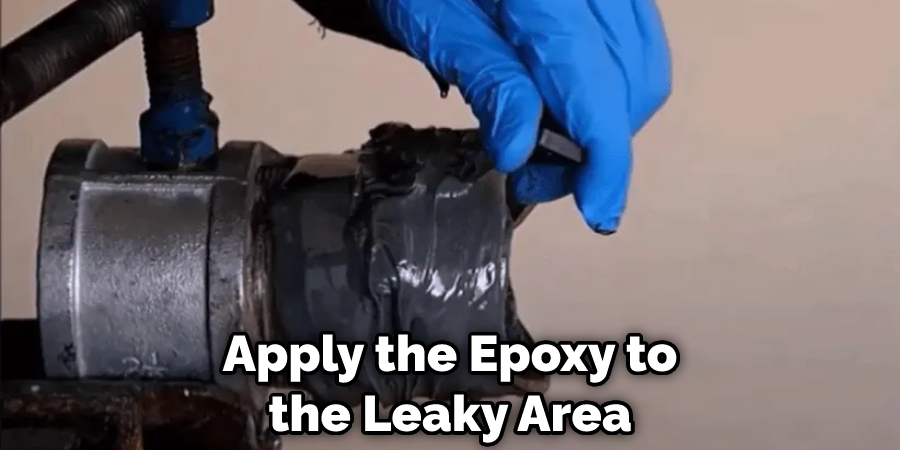
9. Seal Larger Leaks with Flexible Caulking:
For larger leaks, you’ll need to use flexible caulking. Flexible caulking is made for indoor and outdoor use and can be found at most hardware stores. To apply, first clean the area around the leak with a cloth. Then apply the caulking directly to the hole or crack. Next, use your finger to smooth it out, then allow it to dry for the recommended amount of time on the packaging.
10. Use an Epoxy Kit for Serious Leaks:
If you have a serious leak, you may need to use an epoxy kit. Epoxy kits can be found at most hardware stores and home improvement stores. To use, first clean the area around the leak with a wire brush. Then, mix the epoxy according to the manufacturer’s instructions. Apply the epoxy to the leaky area, then cover with a patch. Allow the epoxy to dry for the recommended amount of time before adding water to your pool.
11. Use Flex Seal:
Flex Seal is a rubberized sealant that repairs leaks in your above-ground pool. First, clean the area around the leak and apply Flex Seal directly to the hole or crack. Allow it to dry for the recommended time, then add water to your pool. The Flex-Seal will create a waterproof barrier that will prevent water from leaking through the hole or crack. If the hole or crack is large, you may need to apply multiple coats of Flex Seal.
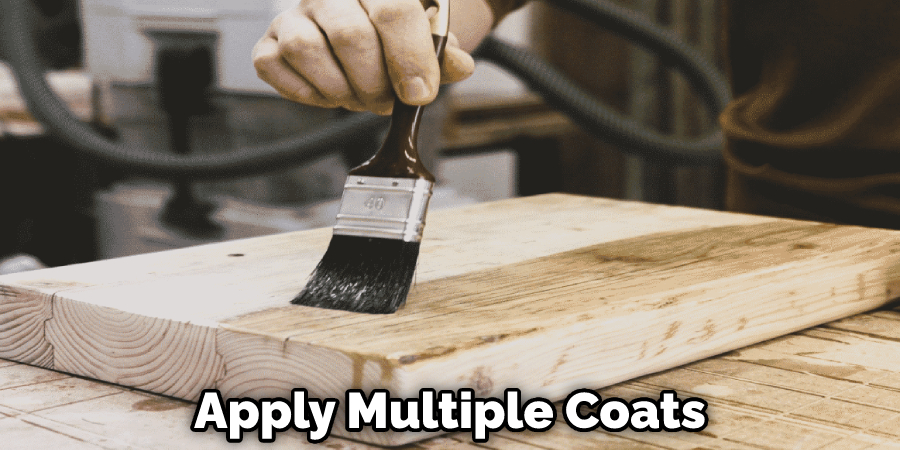
12. Call a Pool Professional:
If you have a serious leak or extensive damage to your above-ground pool, you may need to call a pool professional for help. Pool professionals have the experience and expertise to repair even the most difficult problems.
They can also help you prevent future issues by inspecting your pool and recommending maintenance and repairs. If the damage to your pool is extensive, you may need to replace the entire liner or even the entire pool. In this case, a pool professional can help you choose the best option for your needs.
Few Tips to Avoid Rust & Corrosion Above Ground Pool Wall
- Check your pH and chlorine levels regularly. Maintaining the proper pH and chlorine levels in your pool is the best way to prevent rust and corrosion.
- Use a quality pool cover. A pool cover will protect your pool from the elements and help keep it clean.
- Keep your pool clean and free of debris. A clean pool is less likely to develop rust and corrosion.
- Store your pool properly during the off-season. Your pool should be covered and stored in a cool, dry place when not in use.
- Use a rust inhibitor in your pool water. A rust inhibitor can help prevent rust and corrosion in your pool.
- Inspect your pool regularly for signs of rust and corrosion. If you see any signs of rust or corrosion, take action immediately to prevent further damage.
Proper care and maintenance can prevent rust and corrosion from damaging your above-ground pool. By following these tips, you can keep your pool looking new for years to come.
Frequently Asked Questions
Can You Fix an Above Ground Pool Wall?
Some people might be able to fix an above-ground pool wall, while others may need to hire a professional. It all depends on the extent of the damage and how much needs to be replaced.
In most cases, if the plaster has started coming off or there are holes in it, then fixing it will likely not work. If only small areas need repairs, then people can try using some patches or tacks. But if larger sections need replacing or new walls have to be built altogether, then a contractor would be preferable.
Can You Fix a Bent Pool Wall?
A bent pool wall can be a frustrating and costly problem to fix, but there are a few things that you can do to try and rectify the situation. First, use a jackhammer or chisel to break up the concrete until it is loose enough so that you can work on it with your hands.
Then, use an excavator or backhoe to remove chunks of concrete until you reach the original foundation masonry. Once this is done, put in new footing along with fresh mortar and joint compound for stability. Finally, replace any damaged sections of roofing or tiles as necessary.
If this process doesn’t seem like it will solve your troubles quickly enough, then consider hiring an experienced contractor who specializes in pool repair work. They may be able to help diagnose the issue more accurately and come up with a more cost-effective solution than simply repairing everything piecemeal.
Is It Normal for Pool Walls to Buckle While Filling?
the buckling of pool walls can vary depending on a variety of factors, including the type of pool wall material, the size and weight of the object being filled, and the amount of water being added. In general, though, if pool walls buckle while they are being filled, it is likely due to one or more of the following reasons:
- The pool wall material is not strong enough to support the weight of the object being filled.
- The object being filled is too heavy for the pool wall to handle properly.
- Too much water is being added at once, which causes the pool wall to buckle from the added pressure.
- The pool wall is not properly sealed or waterproofed, which allows water to seep in and cause it to buckle.
If you notice your pool walls buckling while they are being filled, it may be best to contact a professional contractor in order to fix the issue and prevent it from happening again. By doing so, you will be ensuring that your pool remains safe and playable for all users – no matter what!
What Gauge Steel Are Above Ground Pool Walls?
The most popular gauge steel above-ground pool walls are 18 Gauge. This type of steel is strong and can withstand a lot of wear and tear, making it the ideal choice for installing an above-ground pool wall.
Conclusion
The pool wall is one of the most important parts of an above-ground pool. Not only does it hold up the water, but it also keeps people safe by preventing them from falling in. If your pool wall has been damaged, there are a few ways to fix it before the summer swimming season starts. In this blog post, we have discussed a few ways how to fix above ground pool wall
and give you tips on making the repair process easier.
If you are having issues with your above-ground pool wall, these tips can help you fix the problem quickly and easily. We have outlined some of the most common problems and how to solve them in this blog post. Hopefully, this information will help you get your pool back up and running in no time. Have you tried any of these solutions? Let us know in the comments section below.
